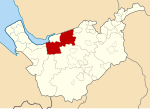Runcorn War Memorial

Runcorn War Memorial was built to commemorate the servicemen of Runcorn lost in active service in the First World War. It was unveiled on Remembrance Sunday 1920 at 3:30pm, beginning a tradition of afternoon services. In 1948, the memorial was rededicated and the names of those lost in the Second World War were added. An inscribed stone was added later with the names of those lost in subsequent conflicts. The memorial, set in a small garden, consists of a Latin cross in white granite on a plinth and steps. The names of the war dead are inscribed on a wall behind the cross. The memorial is recorded in the National Heritage List for England as a designated Grade II listed building.
Excerpt from the Wikipedia article Runcorn War Memorial (License: CC BY-SA 3.0, Authors, Images).Runcorn War Memorial
Moughland Lane,
Geographical coordinates (GPS) Address Nearby Places Show on map
Geographical coordinates (GPS)
| Latitude | Longitude |
|---|---|
| N 53.33343 ° | E -2.73882 ° |
Address
Moughland Lane
WA7 4NP , Runcorn Heath
England, United Kingdom
Open on Google Maps










